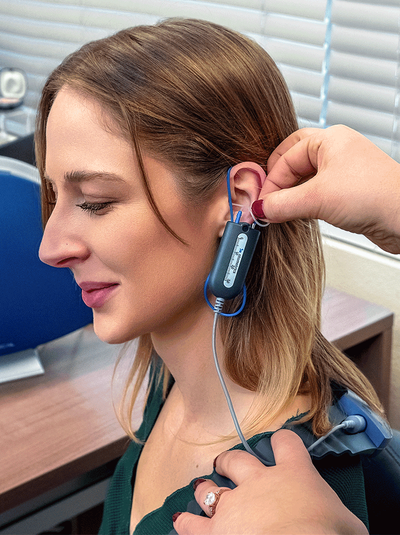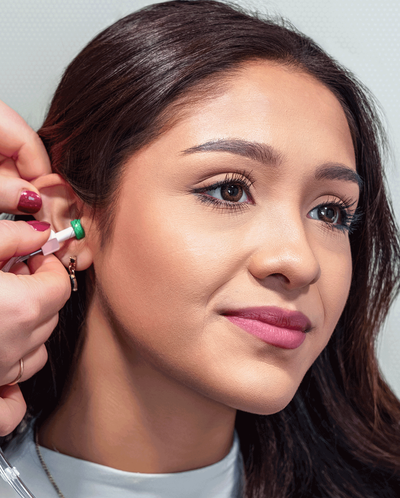What is Hearing?
Hearing is probably one of mother nature's great feats of engineering. Your ear funnels the sound around you into the outer ear (ear canal) and which vibrates the ear drum. The bones in the middle ear then faithfully transmit that sound to the fluid in your inner ear (cochlea), stimulating only the hair cells that correspond to the frequencies around you. Just let any complex system, the more pieces, the more points of vulnerability for something to go wrong. When something does go wrong, it results in a lessened perception of sound, or hearing loss. Learn more about how we evaluate your hearing health.

Conductive vs Sensorineural Hearing Loss
There are two types of hearing loss - conductive and sensorineural. Conductive hearing loss means that the outer ear or the middle ear is responsible for your hearing loss. Examples can include wax in the ear canal, fluid behind the eardrum, a hole in the eardrum or a problem with the bones in your middle ear. Typically, this type of hearing loss can be treated and reversed through medical intervention. For example, getting the wax removed from your ear canal will restore your hearing. Patching up the hole in the eardrum will restore your hearing (the degree can vary depending).
Sensorineural hearing loss, refers to hearing loss in the inner ear. The cause can either be the hair cells and auditory nerve, hence the name. This type of hearing loss is permanent and cannot be restored. A sensorineural hearing loss can be sudden following a viral infection or more commonly, occurs gradually. A gradual sensorineural hearing loss is a result of wear and tear of the cochlea from environmental toxins and noise exposure. Typically, a patient will start to notice this type of hearing loss as early as 50 years of age. Everyone will eventually develop hearing loss with age but the onset of age-related hearing loss is dictated by several factors - genetics, noise exposure (loud noise, power tools, fire arms, etc), secondary health conditions (diabetes, high blood pressure, sleep apnea), and environmental toxins (chronic use of nicotine and/or alcohol, medications that are known to damage the hair cells such as cancer treatment).

Why is sensorineural hearing loss permanent?
Unlike some animals (like birds and fish), humans lack the ability to regrow cochlear hair cells or regenerate auditory nerve fibers. This is why a sensorineural hearing loss is permanent. However, this does not mean we cannot treat sensorineural hearing loss.
Treatments for sensorineural hearing loss
Hearing doesn't stop at the cochlea. From there the auditory nerve transmits the signal to the brain which makes sense of the sounds we are hearing. Usually, a sensorineural hearing loss means the cells are not healthy enough to pick up the soft sounds but the brain is still able to make sense of the information. So if the signal is made loud enough for the haircells to pick up the sounds, the brain knows what to do with that information. This is where hearing aids come in handy.
What are hearing aids?
Hearing aids are FDA-approved devices that help compensate for your hearing loss. Hearing aids will only amplify at the specific frequencies you have hearing loss in order to provide the auditory nerve with the information needed to send to the brain for interpretation. Hearing aids additionally are able to suppress background noise to help the brain more easily understand and interpret what we want to hear - speech. Recent research has shown that using hearing aids may help reduce the risk of cognitive decline and dementia.
When should you consider hearing aids?
- You have difficulty understanding dialogues in movies and TV shows.
- You have trouble following conversations in group settings and noisy environments.
- Speech does not sound as clear as it used to be.
- You hear ringing in your eyes that sounds like a high-pitched tone, buzzing, or humming. Learn more about tinnitus treatment options.
How to verify you need hearing aids
A hearing test is the most objective way to determine if you need hearing aids. Seeing an audiologist for objective testing and to discuss your hearing challenges will help determine if you are a hearing aid candidate. During your hearing test, not only will it reveal your hearing acuity, but also your speech processing abilities. These results together will determine if you are a good hearing aid candidate and what hearing aids would be the best option for you. Learn more about choosing the right hearing aids for your needs.
Do I have to see an audiologist for hearing aids or can I just buy something online?
While there are many options available online, working with an audiologist ensures you get the right hearing aids for your specific needs. We offer transparent pricing and flexible financing options to make quality hearing care accessible. Additionally, our hearing aids come with comprehensive maintenance and repair services to ensure they continue performing at their best.
What to expect with your visit to us.
Dr. Penaroza will start with a comprehensive hearing test that will test all three parts of your ear. She will include tone and speech testing, and will even include a test that simulated a noisy situation to see how your brain is able to inhibit extra noise. She is also a big fan of questionnaires to objectively measure your experience in daily living. Once she has a full picture, she will make recommendations. This can include further testing, auditory training, hearing aids, or assistive devices.
Treating hearing loss with an audiologist is an ongoing rehabilitative journey. Think of it as a life-long dialogue. Should hearing aids be the primary recommendation, she will dedicate a full hour consultation to go over your options. Her recommendations will be based on your test results, your lifestyle, and your reported difficulties. She is also very transparent about pricing and expectations for your rehabilitation. Once you are fit, you will have a 30-day trial period during which time you will wear your hearing aids and follow up with her 2-3 times to help fine-tune the hearing aids to your needs. Afterwards, she will typically see you every 6 months to maintain the hearing aids and continue to guide you on your hearing journey.
